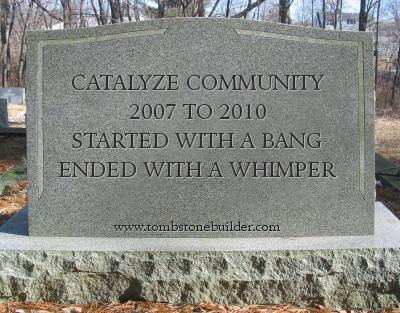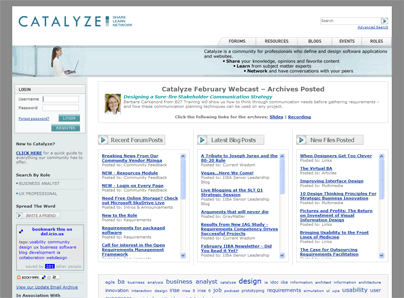The announcement from iRise yesterday today that the Catalyze Community was merging into the ModernAnalyst.com Community probably didn’t even register a blip on your radar. But the announcement has more than a touch of melancholy for me as I was the founding community manager from the conception of the community in late 2006 through its growth to over 4,000 members in July 2008 and I want to give the the community a proper send-off.
Giving birth to and nurturing a community is not unlike the experience of raising children as I lived and breathed the Catalyze Community for almost 18 months. I cut my teeth in community management, tried to set the standard in what professional B2B communities could be, and got started on my journey into social media through my efforts with the community. I learned a great deal and had a chance to develop many friends in the community space including the team from Mzinga who provided the white label social media software that powered the site (a special thanks go out to Jim Storer, Derek Showerman, Aaron Strout, Isaac Hazard, Mark Wallace and Barry Libert). I am sure I drove the Mzinga team a little bit crazy as I pushed the envelope to ‘mold’ their software into my idea of what a community experience should be. I also enjoyed hosting the monthly webinars we held with a wide variety of knowledgeable experts. Most of all, I discovered my “blogging” voice, and was able to experiment with the new and emerging (at the time) social media tools like Twitter, Facebook, Slideshare, and LinkedIn.
Of course, a lot of credit also goes out to iRise who was the founding sponsor of the Catalyze Community. iRise’s funding of the Catalyze Community and mission to keep it ‘commercial-free’ is what drew many of the members into the community.
The demise of the Catalyze didn’t come as a surprise to me as the community has floundered without a community manager for the past two years – and the site had become a virtual ghost town with very few visitors and sadly, very little fresh content. Anyone who understands community building realizes that a site that is not actively managed with fresh content cannot be sustained and is destined for failure which ended up as one of my blog posts in January 2009. In fact, I shared many of my experiences with the Catalyze Community in a number of blog posts.
The original goal of Catalyze was to unite and “catalyze” the disparate factions of business analysts, usability professionals, user experience (UX) and information architects, designers, software developers and others who define, design and create software applications. The ModernAnalyst Community is a very robust community and boasts over 38,000 members – and most of the Catalyze members will be nore than well-served by the merger. I hope that the analytical “left-brain” analysts continue to reach out to the creative “right-brain” designers and usability professionals, and that they can continue to find a common ground in defining and designing better software. I send best wishes to Adrian Marchis and the rest of his ModernAnalyst.com team on continuing the Catalyze tradition.

ModernAnalyst.com


